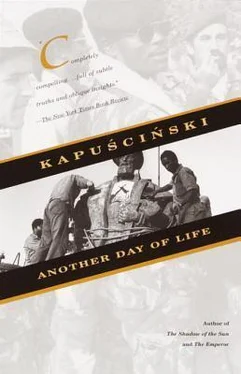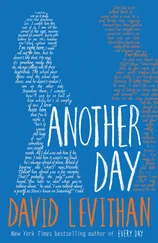1953
The creation of Angola’s first liberation organization, PLUA (Partido da Luta dos Africanos de Angola, “Party of the Struggle of the Africans of Angola”). Like all other subsequent organizations in Angola, PLUA comes into being and operates in conditions of conspiracy.
1954
The creation, in Kinshasa, of the organization UPNA (União das Populações do Norte de Angola, “Union of the Peoples of Northern Angola”). It is the tribal organization of the Bakongo, the germ of the later FNLA.
DECEMBER 10, 1956
From the union of PLUA with other, small liberation groups, the MPLA (Movimento Popular para a Libertação de Angola, “Popular Movement for the Liberation of Angola”) arises in Luanda. At its head stands the thirty-four-year-old doctor and poet Agostinho Neto.
1958
UPNA changes its name to UPA (União das Populações de Angola, “Union of the Peoples of Angola”).
During this period, as a result of the stormy events in neighboring Congo (Zaïre), many Angolan tribal parties and organizations, mostly small ones, come into being. Until 1967, 58 such parties and 26 organizations appeared on the political stage and then disappeared. The fragmentation of Angola’s political life was greater than Congo’s.
FEBRUARY 4, 1961
The armed attack of MPLA fighters on the prison in Luanda (the so-called Casa de Reclusão Militar), where Angolan patriots are incarcerated. It is the commencement of the armed struggle for the liberation of Angola.
MARCH 15, 1961
In the north, the UPA gives the signal for a racist uprising of the Bakongo against all non-Bakongo. Armed bands of Bakongo murder Portuguese civilians, Angolan mulattoes, members of the Ovimbundu and Kimbundu tribes. The insurrection is suppressed by the Portuguese army and ends with a dreadful massacre of the Bakongo and the emigration of large numbers of Bakongo to Zaïre.
MARCH 23, 1962
The UPA changes its name to FNLA (Frente Nacional da Libertação de Angola, “National Front for the Liberation of Angola”). Its leader is the president of the UPA, a longtime employee of a Belgian company in Congo, Holden Roberto. Roberto was born in 1925 in Angola (in São Salvador), although he spent his whole life in Congo, where he still lives and where he possesses vast business holdings: hotels, restaurants, etc. FNLA was and remains a strictly tribal organization, the party of the Bakongo, whose ambition is the rebirth of the kingdom of the Bakongo and the incorporation into it of the rest of Angola. In 1970 the Bakongo made up eight percent of Angola’s population. Holden Roberto’s group, whose members belonged to the Protestant Church, was always bankrolled, through the Baptist Church, by the American Committee on Africa. The struggle between the FNLA and the MPLA had the additional overtones of religious conflict: the FNLA are Protestants; the MPLA counts many Catholics in its ranks.
NOVEMBER 1963
The government of Zaïre ousts from Kinshasa the headquarters of the MPLA, moved here from Luanda in 1961 after the Portuguese repressions. Conakry, Guinea, becomes the MPLA’s new seat, and then Brazzaville. Beginning in 1965, Brazzaville is home to a one-hundred-strong Cuban military unit, which acts as a security force for the then-president of the People’s Republic of Congo, Massemba-Debat. It is in Brazzaville that the MPLA establishes its first contacts with Cubans.
1964
A split in the so-called Government of the Republic of Angola in Exile (GRAE), created two years earlier by the FNLA. Among those quitting the GRAE is the minister of foreign affairs, Jonas Savimbi, who, in the periodical Remarques Africaines of November 25, 1964, publishes a letter accusing Holden Roberto of corruption and nepotism. First, Savimbi cites the names of CIA agents working within the FNLA, then lists the roster of the FNLA leadership, which is worth quoting: “Holden Roberto, president, born in São Salvador; John Edouard Pinock, born in São Salvador, Holden’s cousin; Sebastião Roberto, born in São Salvador, Holden’s brother; Joe Peterson, born in São Salvador, Holden’s brother-in-law; Narciso Nenaka, born in São Salvador, Holden’s uncle; Simão de Freitas, born in São Salvador, Holden’s nephew; Eduardo Vieira, born in São Salvador, Holden’s cousin.”
MARCH 13, 1966
UNITA comes into being (União Nacional para a Independência Total de Angola, “National Union for the Total Independence of Angola”). The creator and leader of this organization is Jonas Savimbi, born in 1934 in the province of Bié, the son of a railroad worker. He had studied in Europe for a time. He underwent military training in Beijing (1964–1965). UNITA was financed by Portuguese settlers, who later created the organization Frente de Resistência Angolana: FRA. The leaders of the FRA were Colonel Gilberto Santos e Castro, the subsequent commander of the mercenaries fighting alongside the FNLA, as well as the millionaire and banker Antonio Espírito Santo. They wanted to wrest Angola from Portugal and create a state of white settlers (as Ian Smith had done in Rhodesia). UNITA, like the FNLA, is a tribal organization. Its members are recruited from the people of the Ovimbundu tribe. Savimbi, who for years quarreled with Holden Roberto, later created with him a common front against the MPLA. I remember the poster on which Savimbi and Roberto are embracing each other. The words: “Two leaders — one sun of freedom!”
1968
The MPLA moves its headquarters from Brazzaville to the forests of eastern Angola. The armed conflict intensifies.
APRIL 25, 1974
Revolution in Portugal.
JANUARY 15, 1975
The signing of an accord in Alvor, Portugal, between the MPLA, FNLA, UNITA, and the Portuguese government, creating a provisional coalition government in Angola and granting it independence on November 11, 1975.
JANUARY 30, 1975
The provisional government goes into effect in Luanda. Five months later, the FNLA and UNITA resign from it.
MARCH 1975
Bloody riots in Luanda. The civilian population of the capital, declaring itself for the MPLA, is attacked by the troops of the FNLA.
APRIL 17, 1975
A split in the MPLA. The chief of staff of the MPLA army, Daniel Chipenda, goes over to the FNLA. One of the founders of the organization, Mario de Andrade, also leaves the directorate of the MPLA.
JULY 1975
The MPLA liberates Luanda from the divisions of the FNLA. The majority of Angola’s territory comes under the control of the MPLA.
AUGUST 27, 1975
The troops of the Republic of South Africa first enter Angolan territory in the Cunene region. In a skirmish with them the commander of the southern front of the MPLA, Comandante Kalulu, is killed.
OCTOBER 19, 1975
The first Cuban army unit arrives in Luanda.
NOVEMBER 11, 1975
The creation of the People’s Republic of Angola. In accordance with the MPLA program, the new republic is to be a people’s democracy, in which the principal natural resources, as well as the principal elements of the economy, will be the property of the state. All citizens have a right to employment and education. Angola will conduct a politics of positive neutrality. Agostinho Neto becomes the republic’s first president.
NOVEMBER 1975
The start of the counteroffensive by the army of the MPLA, supported by units of the Cuban army. During December and January the armies of the FNLA and UNITA are destroyed.
JULY 3, 1976
The destruction of a detachment of mercenaries commanded by the so-called Colonel Callan.
MARCH 27, 1976
The last South African army units withdraw from Angolan territory. They return along the same road that I once drove with Diogenes, and later with Farrusco, eaten by a fear I will never forget. Where is Farrusco now? Alive, probably. People in Lubango hid him during the invasion, he lay there for a long time, his wounds finally healed. He was a tough man. I don’t know what happened to Diogenes. I would like to think that he’s alive, too. Antonio was killed. Carlos was killed. It is calm on all fronts.
Читать дальше











